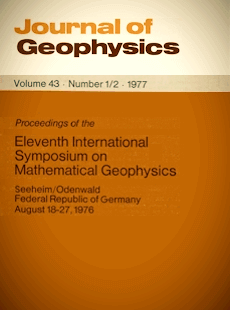Three dimensional seismic velocity anomalies in the lithosphere
Article Sidebar

Vols. 1-18 (1924-1944), ISSN 0044-2801
Main Article Content
Abstract
This paper discusses cruxes of the method for inverting the P-time residual data introduced by Aki et al. (1976a) and summarizes the results obtained by the method on 3-dimensional seismic velocity anomalies in the lithosphere under several seismic arrays around the world. The velocity anomalies at shallow depths correlate well with geologic features in young, active areas such as California, Hawaii, and Yellowstone, but the correlation is not apparent in old, stable areas such as eastern Montana and Norway. Significant small scale (20~50 km) lateral inhomogeneity is observed everywhere to the depth of 100~150 km, with the minimum estimate of root mean square fluctuation about 3%. The lithosphere-asthenosphere boundary seems to manifest itself as change in the roughness of anomaly pattern or in the trend of anomaly.
 ARK: https://n2t.net/ark:/88439/y086778
ARK: https://n2t.net/ark:/88439/y086778
Permalink: https://geophysicsjournal.com/article/218
Article Details
References
Aki, K., Christoffersson, A., Husebye, E.S. (1976b) Three-dimensional seismic structure of the lithosphere under Montana LASA. Bull. Seisrn. Soc. Arn. 66:501-524
Berteussen, K.A. (1974) NORSAR location calibrations and time delay corrections, NTNF/NORSAR. Sci. Rep. No. 2-73/74
Chiburis, E.F., Ahner, R.O. (1973) LASA regional travel-time corrections and associated nodes. SDAC Technical Report No. 73-76, AD 774458 Teledyne, Geotech, Alexandria, Virginia
Eaton, G.P., Christiansen, R.C., Iyer, M., Pitt, A.M., Mabey, D.R., Blank, H., Zietz, I., Gettings, M.E. (1975) Magma beneath Yellowstone National Park. Science 188, No. 4190:787-796
Ellsworth, W.L., Koyanagi, R.Y. (1976) Three-dimensional crust and mantle structure of Kilauea volcano, Hawaii. Submitted to J. Geophys. Res.
Franklin, J.N. (1970) Well-posed stochastic extension on ill-posed linear problems. J. Math. Anal. Appl. 31:682-716
Husebye, E.S., Christoffersson, A., Aki, K., Powell, C. (1976) Preliminary results on the 3-dirnensional seismic structure of the lithosphere under the USGS Central California Seismic Array. Geophys. J. R. Astr. Soc. 46:319-340
Iyer, H.M. (1976) Personal communication.
Kind, R. (1972) Residuals and velocities of P. waves recorded by the San Andreas Seismograph network. Bull. Seisrn. Soc. Arn. 62:85-100
Lancsoz, C. (1961) Linear differential operators, pp. 564. Van Nostrand, London-New York
Zandt, G., Aki, K. (1976) Lateral velocity anomalies associated with the San Andreas fault, central California. Trans. Arn. Geophys. Union, EOS 57:283











